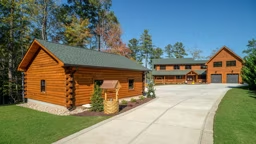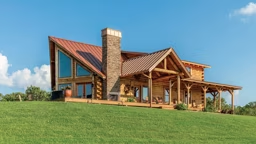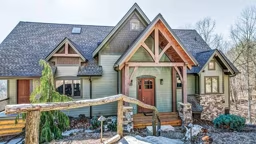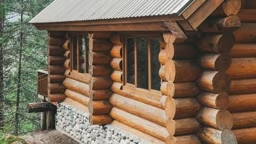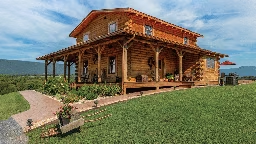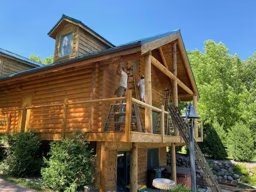
The two greatest threats to wood’s beauty and longevity are moisture and sunlight. Though these two potent forces alone won't significantly degrade the surface of your logs, they might set up conditions under which more destructive forces can get a foothold and, if ignored, prevail.
How do you protect your log home's wood? Follow these simple guidelines:
Keep Logs Dry
Protecting your log home is fairly simple. Best of all, you have the opportunity to set up a preventive maintenance program for your new log home at the outset. You will become acquainted with your logs when they are in their best shape. To keep them that way, you need to ensure they stay smooth and dry.
Some people believe that using certain wood species known to have natural decay resistance will relieve them of a large part of the maintenance requirement of owning a log home. What is a characteristic of the living tree will not necessarily be that of the log. What’s more, modern preservatives neutralize any natural advantage one wood species may once have enjoyed over another.
The strongest wood left unprotected will succumb to the forces of nature sooner than the weakest protected wood. Again, those forces that must be guarded against are sun and water. Sun breaks down the lignin in the wood. Lignin holds the wood fibers together. Once lignin has been broken down, water can wash away the now-loose wood fibers.
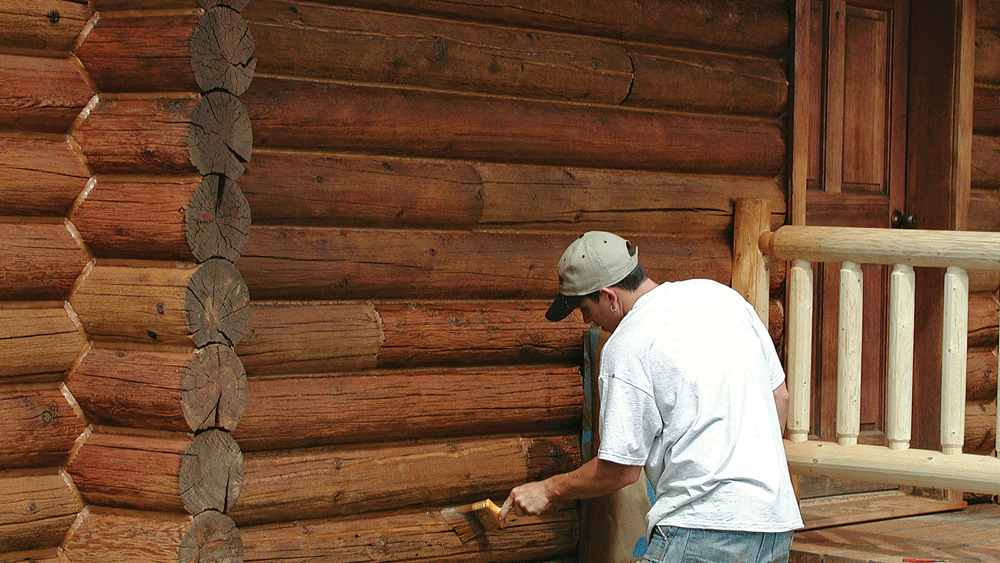
Watch for Fungi
Weakened wood is vulnerable to fungi, which feed on the sugars and starches in wood. Left unchecked, fungi will eventually destroy the wood. Of lesser concern than fungi are insects. Two kinds pose the greatest danger: termites and wood-boring beetles. Fortunately, you can easily guard your logs against these threats. Several formulations of wood finish expressly protect logs.
They add mildewicides, fungicides, ultraviolet blockers and water repellents to ensure maximum protection. High-quality, breathable wood finishes will keep additional moisture from penetrating the wood while allowing moisture inside the log to evaporate. Apply only products that are intended to protect log homes. Deck sealer is not sufficient. If you are in doubt about specific products to use, check with your log producer or its local sales representative.
Log homes are subject to varying conditions, which will determine the lifetime of the finish. The only way to ensure permanent protection is to implement a systematic, regular maintenance program. It should begin even before you buy your logs. There are some simple steps you can take to protect your logs from the start and reduce the cost of maintaining your logs forever.
Design Defense
Above all else, design your home to shed water and shade sun. Caulk and coatings can do just so much. Besides, they eventually fail and need to be replaced. Good design lasts a lifetime. Your practical aims won’t interfere with the look of the home. In fact, you can actually enhance the home’s distinctively log features.
Elevate your logs. Wood that comes in contact with the damp ground quickly succumbs. Splashing mud will hold moisture long enough to penetrate weakened protection. One way that actually improves the look is to set the logs on a taller foundation, then face the block, poured concrete or permanent wood structural material with stonework or log siding that mimics the wall logs.
Extend roof overhangs to keep rain, melting snow and sunlight well away from walls. Porches protect against blowing rain and the overhead sun, as well as enhance your home’s charm. Gutters and grading help move water away from the house. Be sure lawn sprinklers don’t reach the log walls.
When you landscape, keep any shrubs around the house from touching the logs; otherwise, they can trap water against the wood. Although you might prefer to shade the house with trees, don’t keep them so dense and close that some sunlight and breezes can’t get through to help dry the logs.

Begin at the Source
Once you have a design that can keep the forces at bay, make sure your log producer takes proper steps to protect the logs from mold and mildew, starting within 24 hours of when they are milled, peeled or hewn. The logs should be delivered in good shape and properly stacked to keep them off the ground and covered to keep off moisture (but loosely enough so they can breathe).
They may arrive with some road grime. A little trisodium phosphate in water will clean that off. One measure you might consider is pre-treating your logs. They can be dipped, sprayed or pressure-treated with a preservative.
Usually it’s a borate product. Water-based borate wood preservatives are effective against termites, boring beetles, carpenter ants and wood-decay fungi. They are easy to apply, odorless and non-corrosive. The aim is to produce a concentration of the borate solution below the surface of the wood that is lethal to wood-eating insects by disrupting their digestive process and adds protection against the fungi that cause wood rot.
Besides being applied in several different forms before the logs are erected, borate products are available for protection after the home is built. Spray products are particularly effective in making sure the protection soaks into wood in hard-to-reach areas.
Whether your logs arrive pretreated or untreated, once the walls are erected, the logs should be protected with a stain or sealer to keep the logs from absorbing water. The more pigment that is in your stain, the greater will be your protection against UV rays, which can weather wood.

Ongoing Protection
Don’t assume that protection will last a lifetime. Depending on your home’s exposure to the elements, it could need re-treatment anywhere from three to six years. The best way to keep track of your protection is regular inspections. Give the home a good going over at least every spring and fall. A home’s first two years are probably the most crucial.
This is when the most log movement occurs, while the home settles. Shrinking logs may create moisture traps at horizontal seams, overlapping corners and joints around windows and doors if they are not properly sealed. Check all the walls, not just one or two or three. The southwest-facing corner of the home is usually the first place where protection weakens because it is exposed to more sun, so give it better than a once-over.
Pay particular attention to exposed log ends, especially if your roof doesn’t completely overhang them. They bear the brunt of the weather. Look for cracks, called checks, in log surfaces, particularly upward facing ones. They appear when the outer layer of your log dries faster than its core.
Checks are common but should be filled, with either a coating or caulk, to eliminate water from being drawn deeper into the wood, where more serious problems can develop. Patch gaps in caulk and chinking promptly. Re-caulk and re-chink completely as often as necessary to ensure the sealing materials are performing to their maximum capacity.
Any moisture that gets caught behind a hole in caulking or chinking may not evaporate as quickly as it should, making the wood vulnerable. It’s never a good idea to paint logs or use any other closed-film coating, such as varnish, that can trap moisture inside the log. These coatings will crack as the logs expand and contract. Any water that gets into these cracks can start the decay process.
But there are many stains that can change the color of your logs. Some people like to leave the wood natural, others prefer theirs darker or lighter. A clear finish may seem like a good idea; if the sun in your area is particularly harsh, however, more pigment offers better protection.

Fix Problems
When you do notice something amiss on your exterior, you will have to evaluate whether a touch-up is required or it’s time to redo the whole house. Try spraying the house with a garden hose. If the water still beads up over most of the log surface, your protection is good.
Wherever it doesn’t bead up and soaks into the wood instead needs protection fast. Cleaning the logs and reapplying a preservative or finish is a chore you may be able to handle yourself. Doing so may seem more trouble than it’s worth, but you at least will be able to assure yourself that the job has been done properly.
If you are buying a relatively new existing log home, you will be instituting your own maintenance program in case the previous owner wasn’t as careful as you intend to be. Don’t have unrealistic expectations, however. No log will keep its original hue. That’s the nature of a natural material.
Although you can never restore their original beauty, you can come close, provided you haven’t been too neglectful over the years. Vigilance and diligence can keep the weather from interfering with the natural lifespan of your log home. That way, you also won’t have to worry about the few but constant threats to your logs.
The resulting peace of mind will allow you to enjoy your new home even more, knowing it will stand strong and solid for generations to come.




